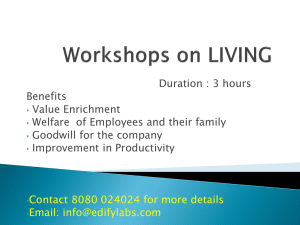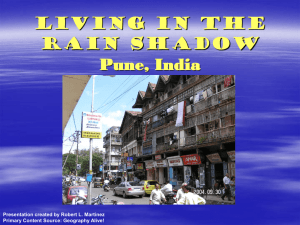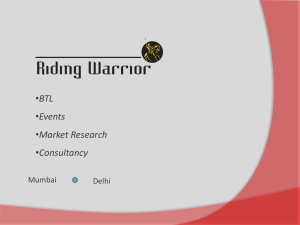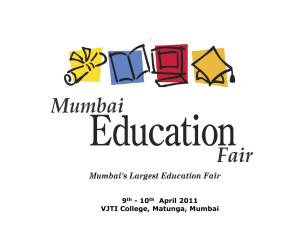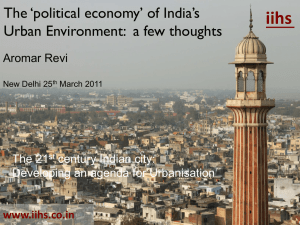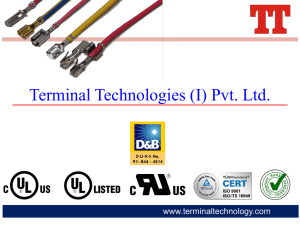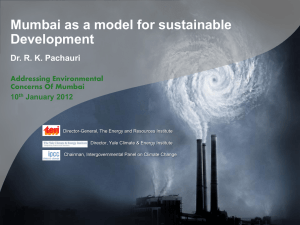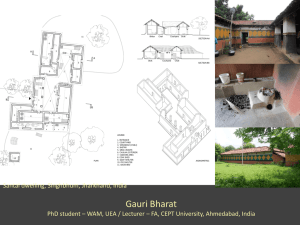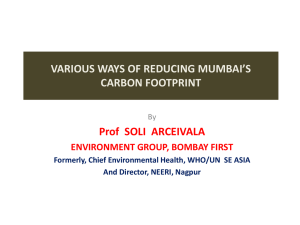PUNE-MUMBAI-AHMEDABAD HSR Pre-Feasibility Study
advertisement
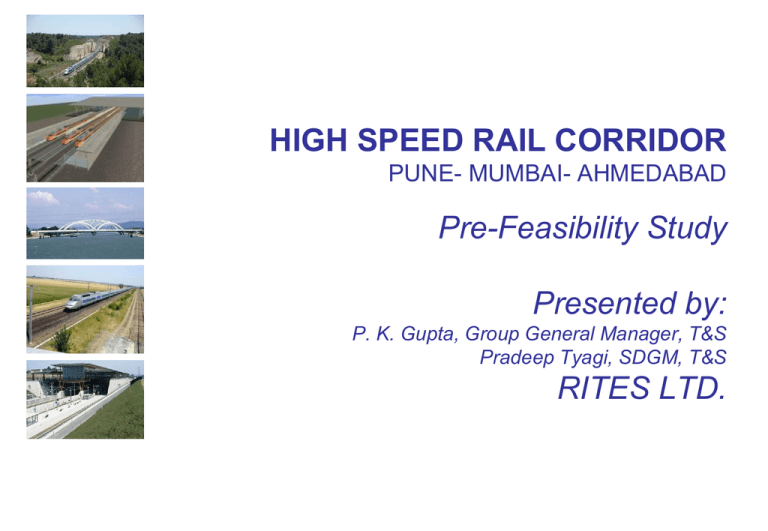
HIGH SPEED RAIL CORRIDOR PUNE- MUMBAI- AHMEDABAD Pre-Feasibility Study Presented by: P. K. Gupta, Group General Manager, T&S Pradeep Tyagi, SDGM, T&S RITES LTD. CONTENTS 1. 2. 3. 4. 5. 6. 7. 8. 9. Background & Salient Features Traffic Forecast Concept Design Alignment Station Locations Costs Estimates Environment Studies Financial and Socio Economic analysis Conclusion Study for PUNE- MUMBAI- AHMEDABAD by RITES, SYSTRA & ITALFER Salient Features States: Maharashtra/Dadra-Nagar-Haveli (UT)/ Gujarat Length: 640 Km double track Maharashtra: 328 Km Dadra-Nagar-Haveli: (UT) 5.5 Km Gujarat: 306.5 Km Length on Bank: 549 Km Length on Bridges: 72 Km Length in Tunnels: 19 Km No of Road Over Bridges: 130 Nos Quantity of Earthwork 76 millions cu.m Tunnel between Lonavala and Karjat 18.3 Km Mumbai HSR Trans Harbour Link bridge: 17.2 Km 3 Main Terminal Stations at Mumbai, Pune and Ahmedabad 3 Intermediate Stations at Navi Mumbai Airport, Surat and Vadodara. 2 Depots : Main Depot Geratpur (Ahmedabad) /Auxiliary Depot (Pune) TRAFFIC FORECAST PUNE-MUMBAI-AHMEDABAD 26.6 Million passengers per year in 2021 104 Million passengers per year in 2041 24.0 passengers – year 2021 TRAVEL TIMES AHMEDABAD VADODARA SURAT Substantially shorter running times Saving of 2/3 compared to existing running times PUNE Standards of Construction Gauge : 1676mm (Broad Gauge) Speed : 350km/hr Ruling Gradient : 3% Radius of Curvature : 6425m Axle Load : 17 ton Track structure : Ballastless Interoprability : Full with existing railway network Signalling & Telecommunication • Signalling: ETCS Level 2 with GSMR • Telecommunications: GSMR • Operation Control Centre ( OCC) One single OCC in Mumbai including Train Traffic Control and Sub-Stations Control OVERHEAD CATENARY SYSTEM (O.C.S.) Power Supply – 2 x 25 KV PS – 8 no Sub - Stations O.C.S. 2x25 KV - Either French, German / Chinese Technology - 1 Messenger Bz 116mm² - 1 Contact wire Cu Mg150mm² - 1 Negative feeder Al Ac 288mm² - 1 Aerial earth conductor Al Ac 93mm² - Dropper cable Bz 12mm² - Maximum span 63m - Contact wire height 5.08m - Catenary encumbrance 1.40m - Maximum tension length 1400m - Sub-station every 50 to 70 km 9 ROLLING STOCK – 1676 mm gauge Rolling Stock – 3300mm car body – EMU – Fleet size: 38 Trains sets in 2021 (Investment cost Rs 6783 Cr) ALIGNMENT Alignment is generally away but within 13 km of existing track Alignment closer to existing track near major cities No Level crossing 2 m high boundary wall on both sides Viaducts in urban areas along existing track Minimum disturbances to existing infrastructures and private properties Intermediate stations in suburbs of the cities to avoid costly works to reach city centres which do not provide sufficient traffic. Section Definition Entire route divided in 3 sections Mumbai-Pune Section (Shedung to Pune) Mumbai Outer (Shedung to Virar) Mumbai-Ahmedabad (Virar to Ahmedabad) Mumbai-Ahmedabad Section Mumbai Outer Area Mumbai-Pune Section Mumbai Outer Area Mumbai-Pune Section Mumbai-Pune Section Item Total length in km Details 96.5 No. of tunnels Length of tunnels (km) No. of viaducts 1 (35m deep) Length of viaducts (km) 15.09 (6.78 along existing 1 18.3 track) Relocation of houses/properties 10 (km along alignment) Radius of sharpest curve (m) Speed restriction 6425 No speed restriction Mumbai Outer Area Item Total length in km Details No. of tunnels 1 0.785 Length of tunnels (km) No. of viaducts 83.75 1 Length of viaducts (km) Relocation of houses/properties 7.83 (km along alignment) 1.25 Radius of sharpest curve (m) Speed restriction 5556 At 1 place Mumbai-Ahmedabad Section Item Total length in km No. of tunnels Length of tunnels (km) No. of viaducts Length of viaducts (km) Relocation of houses/properties (km along alignment) Radius of sharpest curve (m) Speed restriction Details 423 NIL NIL 8 7.88 (2.2 along existing track) 6 5000 At 1 place Mumbai-Pune Section (Khandala Tunnel) Lonawala Ex. Railway Station Plan showing 3-alternatives 680m over burden Perspective view of Khandala Hills Longitudinal Profile along MP-1 SU-2a SU-2 SU-1 Mumbai Connection- options Description SU-1 SU-2 Part of SU2+SU2a Length (excluding Links) 32.85 24.5 21.68 NIL 2.425 2.425 17.24 17.24 16.57 3 9.8 3.1 Port trust Indian Railway Length in tunnels (km) Length on viaducts (km) Relocation of houses/properties (km along alignment) Owner ship of Land of proposed Station Port trust CONNEXION TO MUMBAI Alt. MA-2 Mumbai-Ahmedabad Section (Surat) 2 1 1 2 Surat HSR station Plan showing alternatives at Surat Mumbai-Ahmedabad Section 2 1 Alt. MA-1a Airport Alt. MA-1 4 3 Padra 4 Vadodara HSR station Plan showing alternatives at Vadodara Infrastructures Maintenance – Maintenance Head Office in Navi Mumbai – 3 main Track operational units – 7 No track Maintenance Bases (80 kms interval) – 2 Main Signalling/Telecom/OCS/PS Units – 2 Depots for rolling stock : Main Depot Geratpur (Ahmedabad) /Auxiliary Depot (Pune) – Approximately 330-340 staff Cost Estimates 1 - INVESTMENT COST – Construction – Rs. 49075 Cr – Rolling Stock - Rs. 6783 Cr for 2021 2 - OPERATION COSTS – Rs. 205 Cr, in year 2021 3 - MAINTENANCE COSTS – – Rolling Stock - Rs. 145 Cr, in year 2021 Infrastructure - Rs. 254 Cr, in year 2021 Break up of Construction Cost Items 1- Civils (including Land and Environment) 2- Station 3- Systemsk 4- Depots 5- Project Management/ Risks TOTAL Amount (Rs Cr) 27,243 890 12,327 523 8,092 49,075 Cost Breakup Depots 16 1 Project Mgmt. 44 Civil 25 Systems 12 Land/ Environment Station 2 Environment Studies – Does not encroach into wildlife sanctuaries and national parks – Requires 2560 Ha land • • • • • Agriculture Forest Barren Settlement Water Body – 1926 Ha (75%) - 116 Ha (5%) - 262 Ha (10%) - 51 Ha (2%) - 205 Ha (8%) – Compensatory reforestation for 97,632 trees Environment Studies (Contd..) – Reduction in Air Pollution • • • • • Carbon dioxide (CO2) - 257,300 Tonnes/Annum Carbon Mono oxide (CO) - 1,320 Tonnes / Annum Hydro Carbon (HC) - 154 Tonnes / Annum Nitrogen Oxide (NoX) - 354 Tonnes / Annum Particulate Matters (PM) - 24 Tonnes / Annum – Noise Level at 15 m from centre line - 76.2 dBA (75/70 for industrial, 50/40 for silence zone) – Vibration - 80-85 VdB (60-65) Environmental Cost – INR 292.3 Crore FARE Policy FARE in 2021 • • • • 7Rs/Km (75% of the seats capacity) 7 Rs/Km + 30% for 1st Class 4.5 Rs/Km (25% of the seats capacity) 25% extra charge for short trips (< 150 Km) FARE evolution + 4% /year + 5% every 5 years (over and above) LAND revenues Estimated LAND REVENUE Figures (in Rs crore) Revenues 2021 2026 2031 2036 2040 Mumbai HSR station 267.4 561.1 805.6 1156.5 1544.5 Pune HSR station 36.6 76.8 110.2 158.2 211.3 Ahmedabad HSR station 63.4 133.0 190.9 274.1 366 Total Revenues 367.4 770.9 1106.7 1588.8 2121.8 Financial Analysis . Key Financial Indicators: Pre-Tax Project FIRR 11.42% PPP Project Structuring The Project Structures proposed under PPP mode are: OPTION I Design, Build, Finance, Operate and Transfer (DBFOT) of the entire project by a single Private Developer, who will be responsible for construction , operations and maintenance, thus there will be no interface risk and all revenue risk can be transferred to the private developer. OPTION II - Unbundling the project into different components, so as to make the project components attractive to private players from the perspective of affordability in terms of size and risk allocation. - PPP Project Structuring (Contd.) OPTION I DBFOT of the entire project by a single Developer key parameters • • • • Land provided by IR, VGF - 17% of Project Cost, Soft Loan - 20% of total Debt. Equity IRR – 16% PPP Project Structuring (Contd.) OPTION II A. Build and Transfer of Civil Works • • • • VGF - 40 % of project Cost, Annual Grant - Rs. 2,700 crore, Soft Loan - 20% of total Debt. Equity IRR – 16% B. Build, Operate and Transfer of Systems, Stations, Trains and Depots • • • • VGF - 17% of Project Cost, Revenue share - 53% of fare box collections Soft Loan - 20% of total Debt. Equity IRR – 16% Socio Economic Analysis . Pre-Tax Project EIRR 12.80% Conclusion Project is justifed due to following reasons : Necessary to compete with road and air modes of transport Stops the decline of the railway on the long distance transport segment Provides an attractive transport offer in terms of reduced travel times and connectivity with the existing networks. Despite the high investment cost it is financially and economically sustainable Thanks

